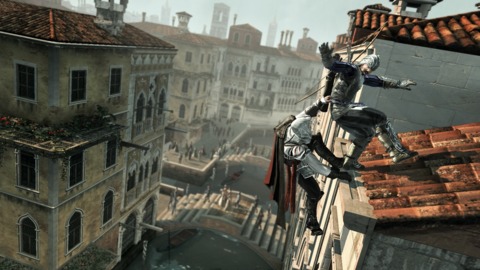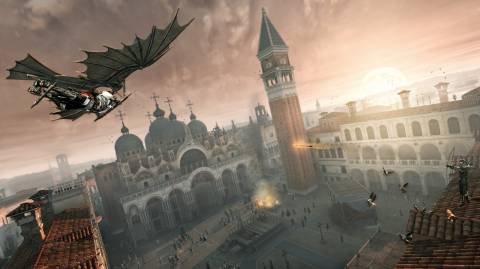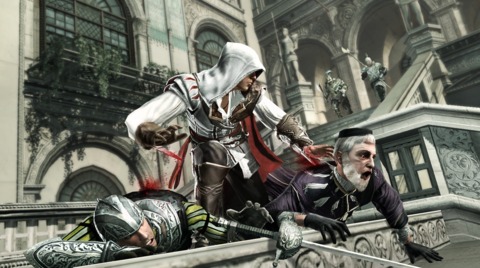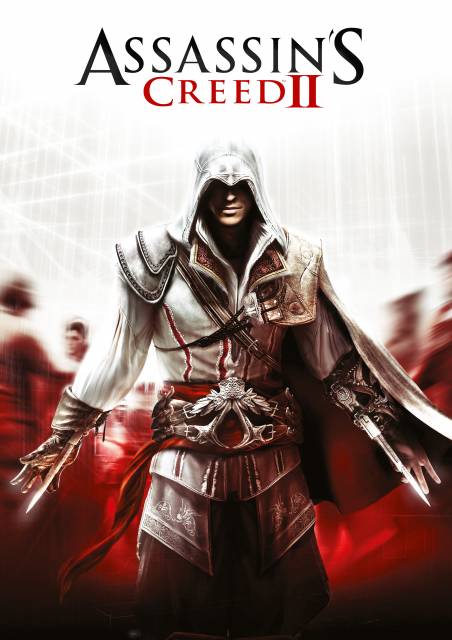A Late Look at Assassin's Creed II
I never played the original Assassin’s Creed. When it was releasing the previews never appealed to me and the general buzz around the game seemed to be that it had a lot of good ideas but executed them poorly. When its sequel released I had already written the series off despite the positive remarks I kept hearing about it. With the release of Brotherhood and seeing it become a game of the year contender, I decided I had to finally jump into the series. With minimal knowledge of the original game, I picked up a copy of Assassin’s Creed II determined to find out what all the fuss was about.
For those who are unaware, Assassin’s Creed II is an open-world game with a strong emphasis on exploration and on-foot traversal. The controls are especially key to how the majority of the gameplay takes place. It forgoes the common mechanics of just jump and grab buttons for exploration and replaces them with the ability to “free-run,” which automates much of the climbing and jumping for the player. Taking that layer of concentration away from the player allows them to focus more on where they’re going, strategize about the upcoming assassination, or keep an eye out for one of the seemingly endless number of collectibles available throughout the game. While not perfect, the system is essential to how Assassin’s Creed II plays and it's hard to imagine the game without it.

The story missions themselves are very impressive as well. The game segments each set of missions into sequences with early missions of a new sequence paying off with a large-scale battle or assassination to end it. The main mission thread never falls into a repetitious rut and keeps the tasks varied, from assassinations to driving a carriage under attack to even piloting Da Vinci’s flying machine. It’s a wonderfully guided experience that never outstays its welcome and is one of the finest points of Assassin’s Creed II.

The ancillary content in Assassin’s Creed II is some of the most interesting I’ve seen in an open world game. It’s rich with missions including races, assassination contracts, waypoints, and catacomb puzzles reminiscent of the Prince of Persia titles. Each mission type feels completely different from the others and unique in their own way. It has a very open interpretation of how to accomplish goals in the side-missions which gives the player a better sense of freedom. Assassinating a target may sound simple, but if he’s surrounded by guards or in a restricted area the task suddenly gets a bit more complex and the game offers a lot of different ways to tackle the same problems, many of which are introduced in the story missions.

The waypoints are a standout piece of side-mission content that deserve adulation. Waypoints are the tallest buildings in a general area that the player must scale in order to display new sections of the map. The waypoint buildings, in that sense, become vertical puzzles in the open world. As new areas open up to the player, a new amount of waypoints are unlocked for them to take on. It’s a very simple task, but the feeling of climbing to the top of a massive building and peering over the edge is one that few games can replicate. It’s hard to get a sense for how massive each town truly is until you can see it from the tallest spots available.
A lot of my thoughts on Assassin’s Creed II are probably things that the first game did as well, but I didn’t feel lost at all making the 2nd in the series my first experience. I was immediately impressed by the well realized world, fluidity of the controls, and how grand everything felt as I jumped rooftop to rooftop in search of more tall buildings to climb. The combat is really my only disappointment in the game, and by my understanding Brotherhood does a lot to remedy this. If you have stayed out of the Assassin’s Creed franchise until now like I have, then I absolutely recommend giving Assassin's Creed II a chance. As for me, I’m just itching to get my hands on the most recent release.
